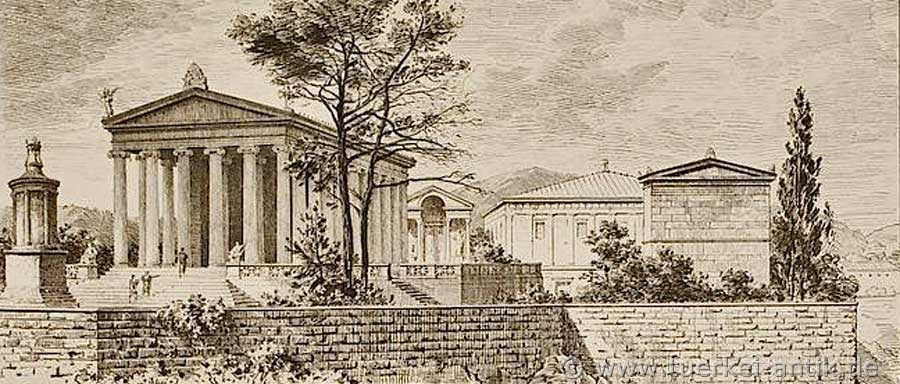 |
| Termessos | |||
|
|
|
||
| Ruin of the Hadrian Temple at today's parking lot | |||
|
According to old traditions, the town of Termessos already existed in the 7th century B.C. The town made a name for itself by plundering pamphil cities in the plain. Due to its protected location and the impregnable defences, the city was able to resist all attackers in the clouds. Even Alexander the Great gave up the attempt to subjugate them in 333 B.C., he only reached the outer city wall. |
|||
|
|
|||
| At the city gate | |||
|
The city can be explored in a tour. You start at the parking lot and climb up the "Königsstraße" mentioned above. About halfway across the threshold of the former city gate of the ingeniously fortified city. The remains of the city wall on the left side give an idea of how mighty it once was. A little higher you pass the remains of a watchtower, of which ten rows of mighty stone blocks have been preserved. |
|||
|
|
|||
|
The Gymnasion |
|||
|
Next you pass the Gymnasion, which stretches 91 meters to the left. If you follow the partly overgrown path, you reach a Roman bath along the relatively well-preserved front of the grammar school. |
|||
|
|
|||
| Access to the Roman bath next to the Gymnasion | |||
|
|
|||
| Reconstructed buildings above the city fortifications (picture below)
(Drawing after Karl Graf Lanckoroński l Städte Pamphyliens und Pisidiens l Volume II, Vienna 1892) |
|||
|
|
|||
| City fortification / retaining wall | |||
|
Coming back from the grammar school to the Königsstraße, the eye is caught by the thickness of the visible and well-preserved inner fortification wall. The theatre is on the next terrace. Once a splendid colonnade street Endlang der Straße, lined with columns, led to it. On both sides there were shops, smaller buildings, porticoes and probably also small temples and statues. A little further uphill you enter the former market complex of the city with the large agora and a cistern. |
|||
|
|
|||
| The Colonnade Street | |||
|
|
|||
|
The Theatre |
|||
|
|
|||
|
The most worthwhile and impressive destination in the maze of trees, wall remains and undergrowth is without doubt the theatre of Termessos. Parts of the stage building and large parts of the rows of spectators have been preserved to this day. The location of the theatre in the rugged mountain scenery is unique. A visit to the theatre alone is worth the strenuous walk up here. The form of the theatre suggests Greek builders, as the typical Roman theatres all have a semicircle. It could only hold 4,200 people and was therefore quite small. |
|||
|
|
|||
|
|
|||
| The Bouleuterion (behind), adjoining the Temple of Artemis | |||
|
Turning south from the theatre, you inevitably come across the mighty remains of the walls of the former, probably covered Odeon, the former town hall of the city. Unfortunately, the inside of the odeon is covered with stones and dense undergrowth. Worth mentioning are the Artemis temples behind the Odeon. At the smaller temple inscriptions have been preserved which refer to an Aurelia Amasta as founder. |
|||
|
|
|||
| Sarcophagus | |||
|
Termessos was and is famous for the tomb of Alketa, a General Alexander the Great, who committed suicide in Termessos after a betrayal and was honorably buried by citizens of the city after his body was desecrated by his adversary. In general, the necropolis of the city are absolutely worth seeing. One of the most interesting tombs in the southern necropolis is the Lion's Tomb, which still contains a barely damaged stone sarcophagus with lion reliefs. |
|||
|
|
|||
| Rock tombs in the West Necropolis | |||
|
The ancient city of Termessos lies approx. 35 km northwest of Antalya at an altitude of approx. 1000 metres in the middle of a magnificent mountain landscape. Coming from Side, take the national road D400 past the airport and turn right at the large intersection after the airport in the direction of Kemer. Now follow the signs to Otogar (bus station). You will inevitably come across the four-lane national road D 650, where the Otogar lies. Take the D650 towards Burdur. About 15 km after the Otogar turn left on the D350, direction Denizli/ Korkuteli. After another 10 km you will reach the well signposted entrance to Termessos Güllük Dağı Millı Parkı |
|||
| Photos: @chim | |||
| Translation aid:www.DeepL.com/Translator | |||
| Source: Wikipedia and others | |||
|
|
|||


